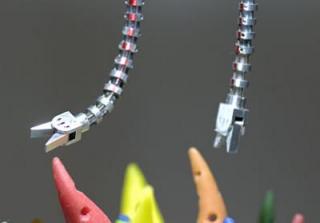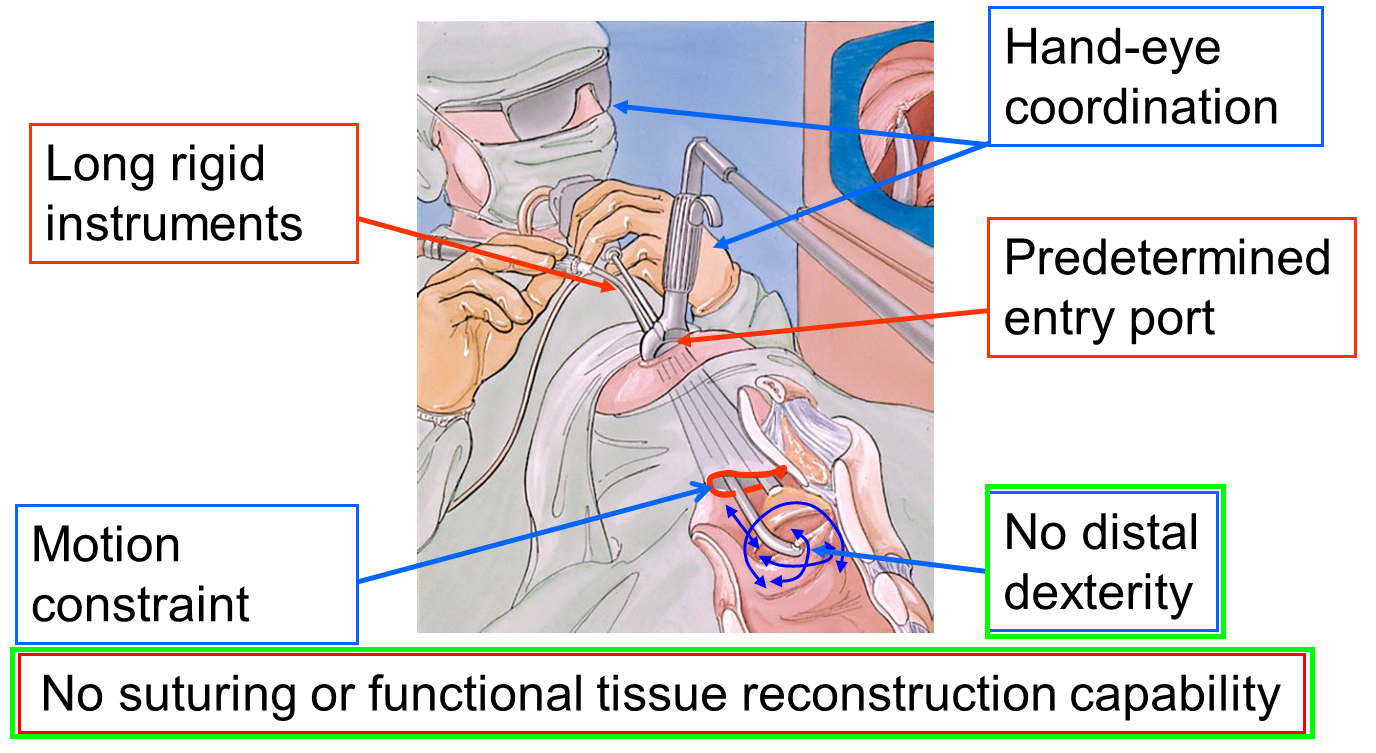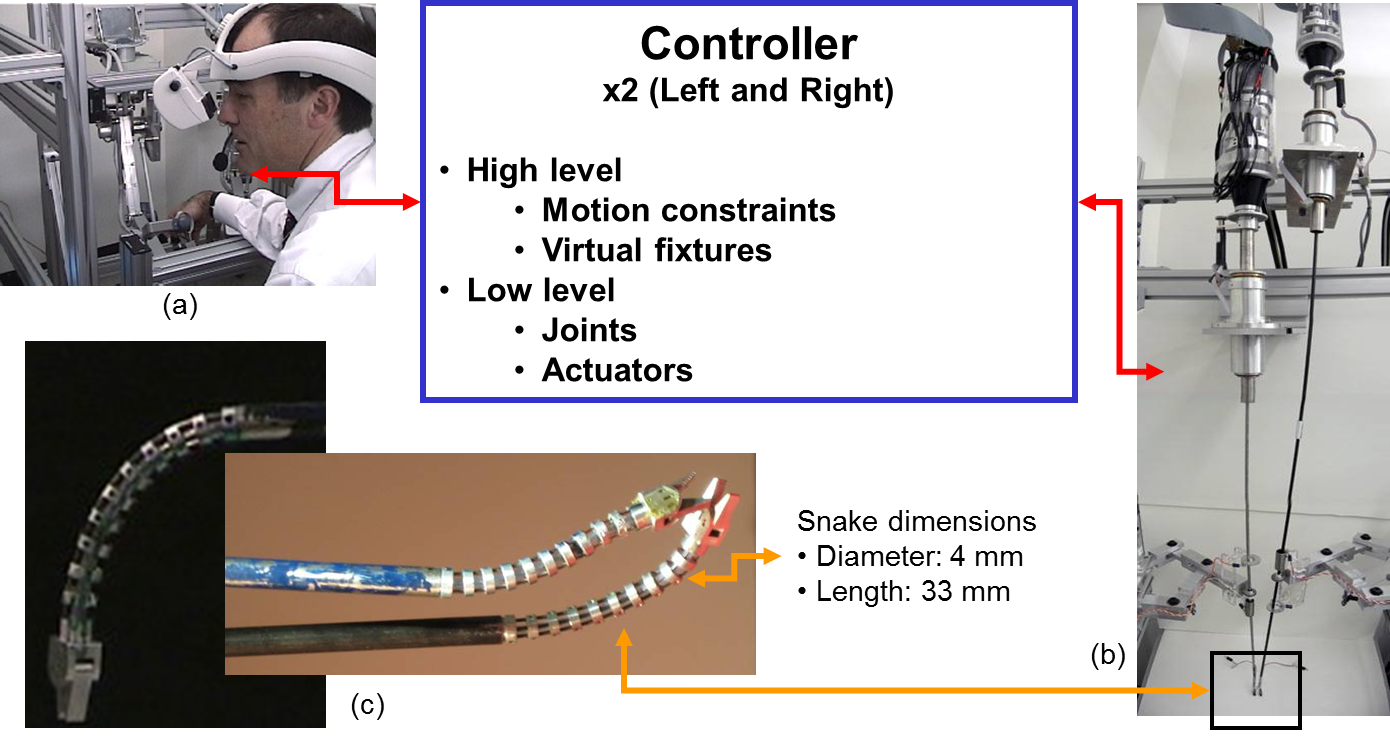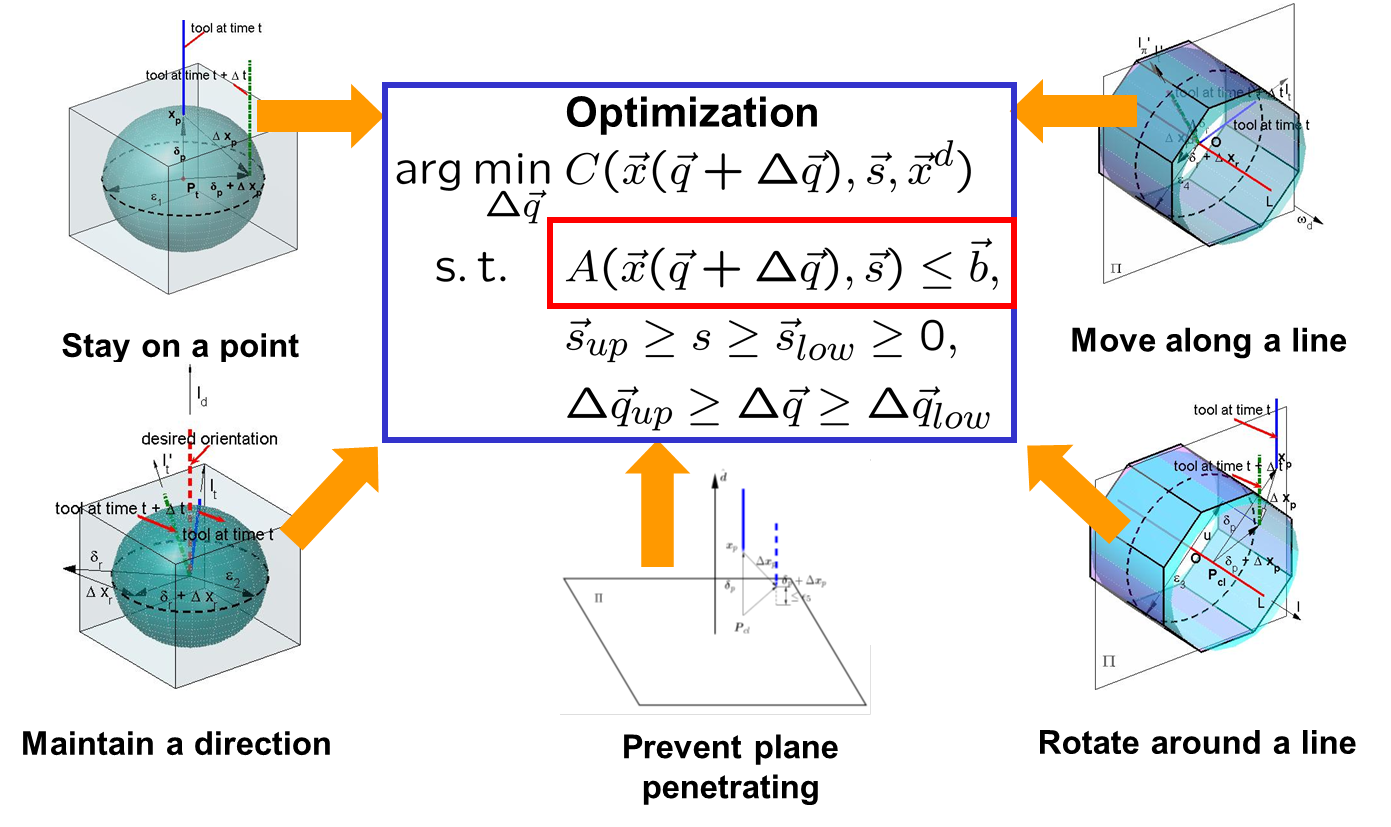Table of Contents
Snake Robot
Problem
The throat is a long, narrow, and irregularly shaped organ, and is often operated on using open surgery. Minimally invasive surgery can be beneficial to patients, but such a procedure presents a number of technical challenges, among them: (1) the throat presents a constrained workspace; (2) existing manual instruments are long, rigid, and awkward to manipulate; and (3) existing tools allow for only four degrees of freedom (dof) with no distal dexterity. Thus there is a limitation in performing precise, time consuming tasks such as suturing.
Solution
The JHU Snake Robot is a telerobotic surgical assistant designed for minimally invasive surgery of the throat and upper airways. It consists of two miniature manipulators with distal dexterity inserted through a single entry port (a laryngoscope). Each dexterous manipulator is capable of motion in four degrees of freedom (dof) and contains a gripping device as the end effector. Three additional dof allow for coarse positioning in the x, y, and z directions, and a shaft rotation dof provides the surgeon the with the ability to roll the gripper while the snake is bent.
Push-pull actuation of super-elastic backbones provides actuation redundancy for enhanced force capability. This unique actuation approach reduces reliance on precision joints, decreases backlash, and makes the device easily down- scalable for mininiaturization. Custom controller electronics and software have been developed for the precise motions of the snake joints.
Methods
Motion constraints, in the form of virtual fixtures, are integrated into the control algorithms in order to assist surgeons with surgical tasks such as suturing and tissue manipulation. Motion constraints also help limit excessive movements and resolve redundancies of the dexterous manipulator. A set of subtask primitives are modeled as linear, multiple objective constrained optimization problems which can be solved in real time for control; complex surgical actions are constructed from combinations of these subtasks.
Results
The dexterous Snake Robot provides surgeons with the ability to suture in confined spaces without large motions of proximal joints. The push-pull actuation mechanism enhances force application capability in comparison with wire-actuated robots. Virtual fixtures integrated into the control algorithms can prove to be useful for complex surgical tasks. They can provide, for example, the ability to perform bimanual tasks with a single hand, with the other hand replaced by another robot. The prototype system validates the whole engineering approach including the kinematics, algorithms, and electronics.
Future Plans
The next step in advancing the prototype towards clinical use is to demonstrate the advantages of a dexterous robotic manipulator over traditional tools. A set of experiments have been designed to compare user performance in knot tying tasks using robot assistance vs. manual instruments. Lessons learned from these trials would pave the way for in vivo verification of the robot and control algorithms. At the same time, more advanced algorithms can be devised to assist in performing surgical tasks and improving efficacy. For instance, virtual fixtures can be recomputed in real time based on tissue motion to adjust to the dynamic environment inherent in surgery. In terms of mechanisms, a flexural transmission joint is planned to allow for parallel alignment of the Snake Robot arms, while the actuation units reside outside of the workspace.
This project is a collaboration between ERC-CISST (Johns Hopkins University), ARMA (Columbia University), and Johns Hopkins Medical Institutions.
Project Personnel
- Graduate Students
- Ankur Kapoor (graduated 2007)
- Kai Xu (Columbia, graduated 2009)
- Wei Wei (Columbia, graduated 2010)
- Paul Thienphrapa (graduated)
- Clinicians
- Paul Flint (now at OHSU)
- Faculty
- Nabil Simaan (Columbia, now at Vanderbilt)
Project Pages
Funding
- NSF #EEC9731478
- NSF #IIS9801684
- NIH #R21 B004457-01
- Internal funds
Affiliated Labs
Publications
- Simaan, N., Xu, K., Wei, W., Kapoor, A., Kazanzides, P., Flint, P., Taylor, R., “Design and integration of a telerobotic system for minimally invasive surgery of the throat,” International Journal of Robotics Research special issue on medical robotics, first published on OnlineFirst on May 27, 2009 as doi:10.1177/0278364908104278, 2009.
- Hillel, A., Kapoor, A., Simaan, N., Taylor, R., Flint, P., “Applications of robotics for laryngeal surgery,” Laryngeal Cancer - Otolaryngologic Clinics of North America, Nasir Bhatti & Ralph P. Tufano Eds., Volume 41, Issue 4, Pages 781-791, 2008.
- Simaan, N., Taylor, R., Hillel, A., Flint, P., “Minimally Invasive Surgery of the Upper Airways: Addressing the Challenges of Dexterity Enhancement in Confined Spaces,” Book chapter in Surgical Robotics - History, Present and Future Applications, Russell Faust (Ed.), Nova Science Publishing, 2007.
- Xu, K., Wei, W., Simaan, N., “Actuation compensation for snake-like robots with redundant remote actuation,” IEEE International Conference on Robotics and Automation, Orlando, FL, pp. 4148-4154, 2006.
- Wei, W., Ku, K., Simaan, N., “A compact two-armed slave manipulator for minimally invasive surgery of the throat,” IEEE/RAS-EMB International Conference on Biomedical Robotics and Biomechatronics, Pisa, Italy, pp. 287-292, 2006.
- Kapoor, A., Xu, K., Wei, W., Simaan, N., Taylor, R., “Telemanipulation of snake-like robots for minimally invasive surgery of the upper airway,” International Conference on Medical Image Computing and Computer-Assisted Intervention, workshop on medical robotics, Copenhagen, Denmark, 2006.
- Kapoor, A., Simaan, N., Taylor, R., “Suturing in confined spaces: constrained motion control of a hybrid 8-DoF robot,” International Conference on Advanced Robotics, Coimbra, Portugal, pp. 452-459, 2005.
- Simaan, N., “Snake-like units using flexible backbones and actuation redundancy for enhanced minaturization,” IEEE International Conference on Robotics and Automation, Barcelona, Spain, pp. 3023-3028, 2005.
- Kapoor, A., Simaan, N., Kazanzides, P., “A system for speed and torque control of DC motors with application to small snake robots,” IEEE Conference on Mechatronics and Robotics, Aachen, Germany, 2004.
- Simaan, N., Taylor, R., Flint, P., “High dexterity snake-like robotic slaves for minimally invasive telesurgery of the upper airway,” International Conference on Medical Image Computing and Computer-Assisted Intervention, Saint Malo, France, 2004.
- Simaan, N., Taylor, R., Flint, P., “A dexterous system for laryngeal surgery: multi-backbone bending snake-like slaves for teleoperated dextrous surgical tool manipulation,” IEEE International Conference on Robotics and Automation, New Orleans, LA, pp. 351-357, 2004.



